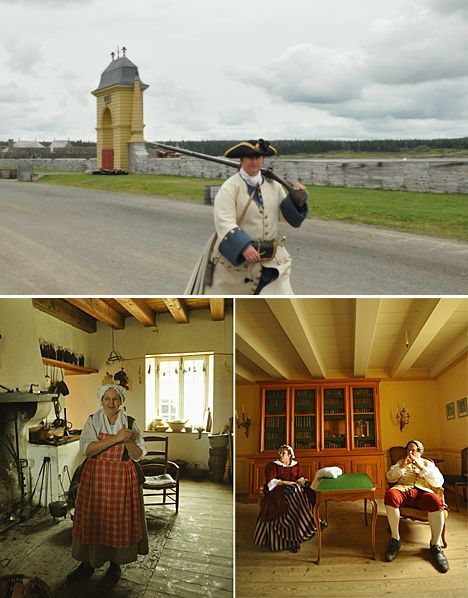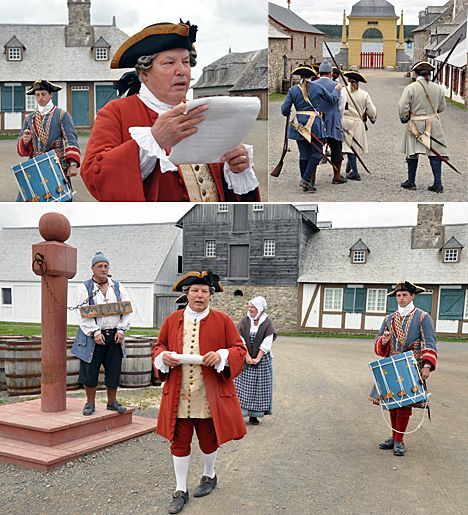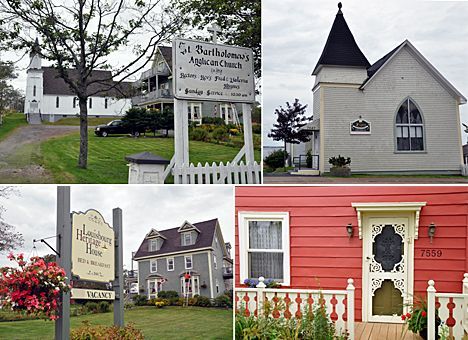Article
Louisbourg, Recapturing the Past
Author(s):
The town of Louisbourg was partially reconstructed in the 1960s using the original stonework. Today, docents in costume march the streets recreating garrison days and occupy the homes that have been restored.
Photography by the authors

View From the Clocktower
Lewis Parker’s painting (detail of authors’ photograph courtesy Parks Canada) shows the fortress of Louisbourg in its heyday. In 1744, for example, when the port’s population was 3,000, during the summer 100 ships would bob in the bay at any one time.
Le Boréal
Parker’s painting shows merchant ships from the West Indies, captured New England vessels and French warships all at anchor, a lot more than when , our cruise ship, ties down in the harbor early in a September morning. The French flag on our stern apparently thrills the receiving committee. A volunteer in costume thrusts a brochure (in English) into our hands yet welcomes us in voluble French.

This settlement on Cape Breton Island was founded in 1713 and fortified twice to resist attacks by Britain. The next half century was a time of wars and “European empire-building.” Fish was important to France, a Catholic country, whose population ate fish twice a week —
and for 40 days at Lent. Cod was plentiful in the cold North Atlantic. It was easily preserved and sent to France.
“The codfish industry made more money for its people than the fur trade ever did,” says our guide, Lucienne Larade. But it was, she continues, a wretched lonely life so far from the mother country, France.
During those wars the French always thought attack would come by sea. Inland was a swamp. In 1745 the New Englanders came —
across the swamp —
and took the town! The settlement was restored to France in a treaty in 1748, but when war broke out again the British attacked successfully again in 1758.
Codfish wasn’t so important to the Brits. They destroyed everything. The site lay neglected. It became a National Park in 1928, a museum in 1936 and finally, in 1961, the Canadian federal government began to restore part of the fortress. It’s time consuming. Of 45 blocks, only five have been brought back to life. Still, visitors get an enticing picture of what the settlement was like in 1744. Louisbourg is the largest reconstruction project in North America.

Docents in costume march the streets recreating garrison days and occupy the homes that have been restored. Voluminous records of the settlement were found in France: 750,000 pages of documentation that include inventories of the homes. The records did not paint a pretty picture of life in France’s colonies in the 18th century. Existence was miserable in this cold wet place, but life in France was scarcely better.
“Ninety percent of the people there lived in abject poverty, but the army did offer a chance for redemption,” says our guide. “With fewer people in a settlement there was less disease —
and food was better than in civilian life. You could ascend socially more easily abroad.”

There were no schools, instead the Sisters from the Notre Dame convent taught the children. There were 15 wells, all polluted. There was one hospital with 100 beds mostly surgical, the common operation being amputation —
on men. The women tended, says the guide, to favor herbal medicine. There was often trouble, she continues, because the port had 24 taverns and only one officer on horseback to patrol the streets. Crimes were handled at the punishment pole near the water’s edge with whipping or branding; or in the town square by hanging.
The tableau staged by the actors in costumes demonstrates a man acclaimed of a crime —
probably infidelity, because when he is labeled and tied to the post his wife seems to celebrate. The proclamation is mostly in French and the cold wind blowing makes the declaration difficult to hear and the small coffee shop across the street in the fortress a more enticing destination. Enticing, too, on this bleak day are the restored buildings with public access.

The Engineer’s Residence has been beautifully restored. Its exhibits show what life was like in the garrison. The engineer lived here for 20 years although his wife, endured one year of the cold, then, homesick, left for France.
Another building tells the story of the Mi’kmaq natives whose land this had been. And where the chapel was planned stands a reference to the Louisbourg Cross taken by the victorious New Englanders after the siege of 1745. The cross somehow ended up at Harvard University and was returned on a long-term loan to the fortress in 1995.

There is time before passengers board the ship for a walk around town although that seems an anti-climax after the fortress visit. The town and the fortress were partially reconstructed in the 1960s using the original stonework. The United States could have learned something in the present recession from how Canada took care of this work. It used the occasion to provide jobs for unemployed coal miners.

The Man Who Cried Orange: Stories from a Doctor's Life.
The Andersons, who live in San Diego, are the resident travel & cruise columnists for Physician's Money Digest. Nancy is a former nursing educator, Eric a retired MD. The one-time president of the NH Academy of Family Practice, Eric is the only physician in the Society of American Travel Writers. He has also written five books, the last called




